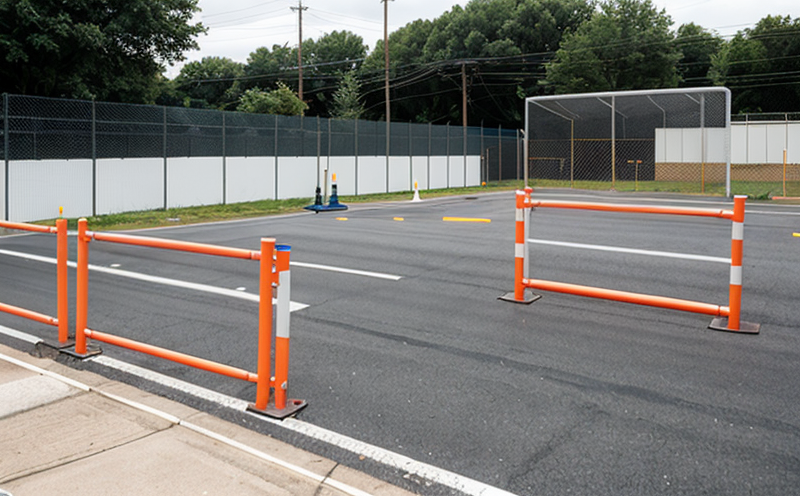EN 166 Protective Shields Fog Resistance Testing
The European Standard EN 166 specifies requirements and test methods to ensure that protective shields and barriers provide adequate protection against various hazards in occupational safety applications. One critical aspect of this standard is the fog resistance testing, which assesses how effectively a shield can maintain its visibility under conditions where fog or mist may impede vision.
Fog resistance testing is essential for ensuring that protective equipment remains functional and safe to use even when exposed to environmental factors like condensation, humidity, and other forms of moisture. This test evaluates the ability of the material used in shields to resist fogging and maintain clarity under controlled conditions. The standard defines specific parameters such as temperature, relative humidity, and duration of exposure that simulate real-world conditions where the protective shield might be used.
The testing process involves exposing the shield to a controlled environment designed to replicate typical workplace conditions. During this period, the shield is subjected to varying levels of moisture content and temperature changes to observe how it performs over time. Once the prescribed exposure duration has been completed, the tester assesses the shield's clarity using defined measurement techniques.
The equipment used for fog resistance testing typically includes a climate chamber capable of maintaining precise control over temperature and relative humidity. A standardized test sample is placed inside this chamber according to specific dimensions outlined in EN 166. The sample undergoes exposure to controlled conditions that mimic actual usage scenarios, including prolonged periods at elevated temperatures or varying humidity levels.
During the testing process, it’s crucial to monitor the shield continuously throughout its exposure time within the climate chamber. Any changes observed in terms of fogging up or loss of visibility are recorded meticulously by the tester. After completing all required exposures, further evaluation takes place outside the climate chamber, where additional tests may be conducted to confirm durability and performance under real-world conditions.
To comply with EN 166 requirements for fog resistance testing, manufacturers must demonstrate that their products meet stringent criteria regarding optical clarity and overall quality. Compliance ensures that workers can rely on these protective shields in potentially hazardous environments without compromising safety or effectiveness due to reduced visibility caused by fogging issues.
The results of this test play a vital role in ensuring occupational health and safety standards are met across industries where personal protective equipment (PPE) is necessary. By adhering strictly to the procedures stipulated in EN 166, companies can enhance worker confidence while also demonstrating regulatory compliance.
Applied Standards
- EN 166:2019 Protective Shields and Barriers - Requirements and Test Methods
Scope and Methodology
The scope of EN 166 fog resistance testing includes the evaluation of materials used in protective shields designed to protect against physical hazards such as flying particles or impact. The primary focus is on ensuring that these shields maintain their optical clarity under specified environmental conditions, thereby preserving the wearer’s visibility during use.
The methodology involves exposing test samples to controlled environments simulating real-world usage conditions. These include variations in temperature and relative humidity levels intended to replicate typical workplace situations where fog or mist could potentially impair vision. The exposure duration varies depending on the type of shield being tested, but it generally ranges between 24 hours for basic models up to several days for more advanced designs.
During this period, continuous monitoring of the exposed samples is conducted using standardized measurement techniques prescribed by EN 166. This allows accurate assessment of any changes in transparency or clarity resulting from exposure to moisture and temperature fluctuations. At the end of each specified exposure phase, additional tests are performed outside the climate chamber to further validate performance under actual usage conditions.
For instance, if a shield is rated for use in high-humidity environments, it will be subjected to humidity levels exceeding 90% RH for extended periods. Conversely, low-temperature exposures might involve temperatures close to freezing point, depending on the application area. These tests aim at identifying potential weaknesses or issues that could arise when used under challenging conditions.
It is important to note that compliance with EN 166 does not only ensure optimal performance but also enhances worker safety by preventing accidents caused by reduced visibility due to fogging up of protective shields. Adhering strictly to these procedures guarantees that manufacturers produce reliable products that meet both current regulatory requirements and industry best practices.
Industry Applications
- Construction Sites: Workers often face adverse weather conditions, including foggy mornings, which can significantly reduce visibility. Ensuring protective shields comply with EN 166 helps maintain optimal working conditions.
- Manufacturing Plants: In environments where particles or dust are present, maintaining clear vision is crucial for operator safety and efficiency. Testing ensures that the shield remains transparent even in challenging industrial settings.
- Hospitals & Healthcare Facilities: Staff dealing with patients in various medical situations need unobstructed views to perform their duties accurately and safely. Fog resistance testing guarantees this critical aspect of occupational safety.





